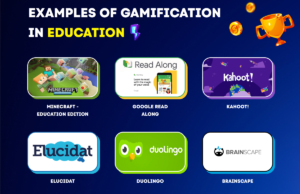WPL Auction 2026 : The Ultimate Guide to Women’s Premier League’s Big Day
Gamification in Education: 7 Powerful Ways to Boost Student Engagement

Gamification in Education
Gamification’s Advantages : Increasing Student Engagement and Learning
In a time when students’ attention spans are getting shorter and learning environments are changing quickly, teachers are always looking for new and creative ways to keep students interested. Gamification, or the incorporation of game-like elements into non-gaming contexts, especially education, is one such technique that has gained a lot of popularity. Gamification has shown itself to be a potent instrument for raising student motivation, encouraging deeper learning, and boosting academic results; it is by no means a fad.
Gamification: What Is It?
Applying components like point scoring, competition, game rules, and rewards to conventional educational activities is known as gamification. Gamification overlays game mechanics on top of conventional learning content, in contrast to serious games, which are fully realised games with educational goals. Gamification overlays game mechanics on top of conventional learning content, in contrast to serious games, which are fully realised games with educational goals. This could involve competing on leaderboards for the highest quiz scores, levelling up after mastering a skill, or receiving badges for finishing assignments.

Increasing Involvement of Students
The rise in student engagement is among the most obvious and immediate advantages of gamification. Conventional teaching approaches can occasionally find it difficult to maintain students’ interest, particularly in settings where the material seems unrelated to personal interests or real-world relevance.
Gamification makes learning more enjoyable and challenging. When assignments are presented as quests or missions, students are more inclined to participate. In addition to maintaining students’ interest, this degree of involvement promotes a more optimistic outlook on education.

Promoting Active Learning
Additionally, gamification encourages active learning, in which students actively participate in their education rather than merely absorbing knowledge. Students are urged to think critically and apply knowledge in novel ways through exercises like interactive quizzes, simulation games, and problem-solving challenges.
Constructivist learning, in which students develop their own understanding via experience and reflection, is consistent with this experiential approach. Gamified activities frequently force students to try new things, fail, adjust, and try again—skills that are essential for both academic and personal development.
Encouragement of Personalised Education
Managing a classroom full of diverse students, each with their own needs, interests, and skill levels, is one of the difficulties in education. A versatile framework for individualised learning is provided by gamification. By providing personalised feedback and progression paths based on individual performance, adaptive learning platforms, for instance, can gamify the process of learning new skills.

Pupils have the freedom to work at their own speed, go over lessons or levels again as needed, and select different routes through the material. This lessens the pressure to compare and permits mastery-based advancement, both of which can greatly increase competence and self-confidence.
Encouraging Teamwork and Social Competencies
Although gamification frequently incorporates competitive aspects, it can also be designed to encourage teamwork. Classroom competitions, multiplayer simulations, and team-based tasks all promote cooperation and a sense of community. In order to accomplish common objectives, students learn how to assign tasks, communicate clearly, and help one another.
These cooperative elements are particularly helpful in preparing students for situations in the real world where teamwork is essential. Additionally, because group-based gamification provides a low-risk opportunity to participate and shine, it can boost participation among reticent or shy students.
Giving Quick Feedback
Instant feedback is one of the key components of gamification, which is important for successful learning. The opportunity for prompt correction and improvement is limited by the fact that traditional grading methods frequently provide feedback days or even weeks after an assignment is finished.

On the other hand, gamified systems frequently have visible progress indicators, instantaneous answer responses, and real-time scoring. By clearly demonstrating their progress, this feedback loop keeps students motivated, helps them identify errors promptly, and reinforces effective techniques.
Using Rewards to Increase Motivation
Leaderboards, badges, and points are used to appeal to both internal and external motivators. Although the ultimate objective is intrinsic motivation, such as curiosity or the desire for mastery, extrinsic rewards can be very helpful in igniting engagement. Students can eventually find the internal fulfilment of learning and growth with the aid of these outside motivators.
Furthermore, “gold stars” are frequently not the only rewards in a gamified setting. They can be connected to special duties, virtual objects, or privileges, which gives the educational process even more depth and significance.

Obstacles and Things to Think About
Gamification has drawbacks despite its many advantages. Excessive competition, frustration, or an emphasis on rewards rather than learning can result from poorly designed systems. To ensure that gamified experiences are inclusive, equitable, and inspiring for every student, educators must carefully craft them to match learning objectives.
Training and access to technology are also essential. For gamification to be implemented successfully, teachers need the appropriate resources and assistance.
Also Read This: Climate Change Explained : Understanding the Science Behind the Crisis
In conclusion
Gamification is a strategic approach that has the potential to revolutionise the educational experience for students of all ages, and it is more than just a trendy term. Gamification capitalises on people’s innate love of play and challenge by making learning more dynamic, personalised, and engaging. It has the capacity to enhance academic achievement, promote lifelong learning habits, and make education a genuinely joyful experience when carefully applied.


